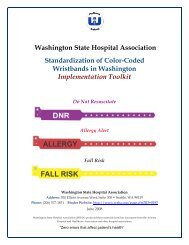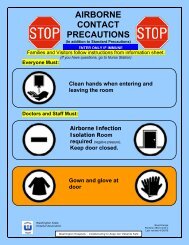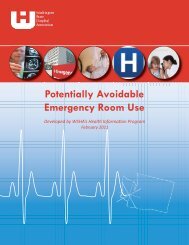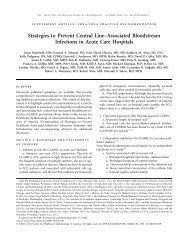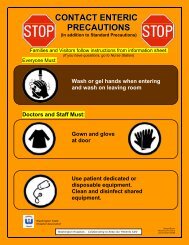Wristband Implementation Toolkit - Washington State Hospital ...
Wristband Implementation Toolkit - Washington State Hospital ...
Wristband Implementation Toolkit - Washington State Hospital ...
You also want an ePaper? Increase the reach of your titles
YUMPU automatically turns print PDFs into web optimized ePapers that Google loves.
Standardization ofColor-Coded <strong>Wristband</strong>sin <strong>Washington</strong> <strong>State</strong>To download a copy of this toolkit, go tohttp://www.wsha.org/page.cfm?ID=0195Carol WagnerVice President, Patient Safety<strong>Washington</strong> <strong>State</strong> <strong>Hospital</strong> Association300 Elliott Ave W, Suite 300Seattle, WA 98119(206) 577-1831carolw@wsha.orgNovember 2009
“Zero errors that affect patient’s health”1
Table of ContentsExecutive SummaryOverview……………………………………….......................... 4Results of Survey………………………………......................... 8Colors for AdoptionDo Not Resuscitate – Frequently Asked Questions………... 12Allergy Alert– Frequently Asked Questions…...…................. 13Fall Risk – Frequently Asked Questions…………………….. 14Policy and ProcedurePolicy and Procedure Sample………………………………… 18Patient Refusal Form…………………………………………... 19Staff and Patient Education MaterialsKey Preparation Before You Start…………………………….. 22Main Points of Training………………………………………... 26Risk Reduction Strategies……………………………………… 30Script for Staff (Sample)………………………………….…… 32Staff Poster (Sample)………………………………………..….. 34Staff Sign In Sheet (Sample)……………………………….….. 38Staff Competency Color-Coded <strong>Wristband</strong>Checklist (Sample)........................................................................ 38Patient Flier (Sample)………………………….......................... 40PowerPoint Presentation ……………………………………… 42Work Plan – How to ImplementSuggested Work Plan…………………………………………... 60Task Chart………………………………………......................... 62Vendor List……………………………………………………...… 68Acknowledgements…………………………………………….... 70“Zero errors that affect patient’s health”2
“Zero errors that affect patient’s health”3
Executive SummaryDo Not ResuscitateAllergy AlertFall Risk“Zero errors that affect patient’s health”4
“Zero errors that affect patient’s health”5
<strong>Washington</strong> <strong>State</strong> <strong>Hospital</strong> AssociationColor-Coded <strong>Wristband</strong>sExecutive SummaryOverview<strong>Washington</strong> hospitals provide very good care for patients. Yet, we know moreneeds to be done to make care safer. Across the nation, hospitals are looking forways that they can reduce the risk of harm to patients. In reviewing adverseevent data from across the nation, it was identified that some errors have comefrom the variation in the use of color-coded wristbands by hospitals. InDecember 2005, a patient safety advisory was issued that brought to light anincident that occurred in a hospital in which clinicians nearly failed to rescue apatient whose heart stopped because the patient was incorrectly designated asDo Not Resuscitate or “DNR.”The source of confusion was the different practices between hospitals on colorcodedwristbands. A nurse placed a yellow wristband on a patient. In thathospital, a yellow wristband meant DNR. In the nearby hospital, where thenurse also worked, yellow meant “restricted extremity” which was what she wastrying to communicate to other staff. Fortunately, another nurse recognized themistake and the patient was resuscitated.As a result, there is a national effort underway to standardize the colors andwording on wristbands.A color-coded wristband is a means to convey or communicateimportant medical information or an alert about the status of a patient.This binder is based on the national agreement of the colors that should be usedby hospitals if they use color-coded wristbands. The <strong>Washington</strong> <strong>State</strong> <strong>Hospital</strong>Association is supporting this effort at the request of members who are lookingfor ways to reduce harm to patients. They believe this process is importantbecause many of our staff and physicians work in multiple hospitals. The<strong>Washington</strong> <strong>State</strong> Nurses Association supports this effort.“Zero errors that affect patient’s health”6
As part of this process, the <strong>Washington</strong> <strong>State</strong> <strong>Hospital</strong> Association conducted asurvey to measure the variation in use of color-coded wristbands in <strong>Washington</strong>hospitals.Following are the survey results for <strong>Washington</strong> –Types of <strong>Wristband</strong>s Color Percent of <strong>Washington</strong><strong>Hospital</strong>s Already UsingDo Not Resuscitate (DNR) Purple 50%Allergy Alert Red 76%Fall Risk Yellow 78%These are the same colors which have been agreed to nationally andimplemented in Arizona, California, Colorado, Nevada, New Mexico, Oregon,Utah, and now the state of <strong>Washington</strong>. The wristbands look like:Do Not ResuscitateAllergy AlertFall RiskThe information presented in this binder is not meant to encourage the use ofcolor-coded wristbands, but to increase safety in those hospitals that use them.“Zero errors that affect patient’s health”7
Results of Color-Coded <strong>Wristband</strong>s Survey in<strong>Washington</strong> <strong>Hospital</strong>sAllergyPercentage of Time<strong>Hospital</strong>s Use This ColorRed 76%Yellow 7%Orange 3%Clear 3%Green 3%Purple 3%Red & White 3%AllergyFall Risk Percentage of Time<strong>Hospital</strong>s Use This ColorYellow 78%Green 11%Purple 11%Fall RiskDNRPercentage of Time<strong>Hospital</strong>s Use This ColorRed 8%Yellow 8%Green 17%Purple 50%Pink 8%Blue 8%Do Not Resuscitate“Zero errors that affect patient’s health”8
This page intentionally left blank“Zero errors that affect patient’s health”9
Colors for AdoptionDo Not ResuscitateAllergy AlertFall Risk“Zero errors that affect patient’s health”10
“Zero errors that affect patient’s health”11
The ColorsColors for AdoptionRecommendation:Use purple for Do Not Resuscitate and label with “DNR” on the wristband.Frequently Asked Questions1. Why did you select purple?Purple was selected to be consistentwith national models, which use thecolor purple to indicate DNR. It justmade sense to continue with anestablished color that has beenimplemented in 15 other statesincluding Arizona, Colorado,Nevada, New Mexico, Utah, Oregon,and California. The American<strong>Hospital</strong> Association is in the processof endorsing this color.2. Why have a wristband for DNR?Registry and traveler staff may notbe familiar with how to accessinformation, when seconds count. Itis also helpful as patients are movedbetween departments.3. If we adopt the purple DNRwristband then do we still need tolook in the chart?Code status should always be doublechecked with the chart so that thespecific wishes of the patient andfamilies can be honored i.e., nomedication, no ventilator, etc.4. Why not use the color Blue?Many hospitals use “Code Blue” tosummon the resuscitation team. Byalso having the DNR wristband as“no code” there would be thepotential to create confusion. “Doesblue mean we code or do notcode?” To avoid creating anysecond guesses in this criticalmovement, we opted not to useblue.5. Why not use Green?Due to color blindness concerns itwas decided to avoid green. Also,in other industries, the color greenoften has a “go ahead” connotation,such as traffic lights. We again wantto avoid any possibility of sending“mixed messages” in a criticalmoment.“Zero errors that affect patient’s health”12
Colors for AdoptionRecommendation:Use red for the Allergy Alert and label with “Allergy Alert” in the wristband.Frequently Asked Questions1. Why did you select red?Red was selected to be consistent withthe national models, which use thecolor red to indicate an allergy. It justmade sense to continue with anestablished color that has beenimplemented in 15 other statesincluding Arizona, Colorado, Nevada,New Mexico, Utah, Oregon, andCalifornia. The American <strong>Hospital</strong>Association is in the process ofendorsing this color.2. Are there any other reasons for usingred?Yes, there are. Our research of otherindustries tells us that red has anassociation that implies extremeconcern. The American NationalStandards Institute (ANSI) hasdesignated red to communicate“Stop!” or “Danger!” We think thismessage holds true for communicatingan allergy status. When a caregiversees a red allergy alert wristband theyare prompted to “Stop!” and doublecheck if the patient is allergic to themedication, food, or treatment they areabout to receive.3. Do we write the specific allergies on thewristband too?No, staff will double check specific allergyin the medical record. It is ourrecommendation that allergies be writtenin one location on the medical record. Wesuggest specific allergies not be written onthe wristband for several reasons:• Legibility may hinder the correctinterpretation of the allergy listed.• By writing allergies on the wristband,someone may assume the list iscomprehensive and one might beomitted.• Throughout a hospitalization, allergiesmay be discovered by other caregiverssuch as dieticians, pharmacists, etc.This information is added to themedical recorded and not always awristband. By having one source ofinformation, staff of all disciplinesknow where to add or find allergies.“Zero errors that affect patient’s health”13
Colors for AdoptionRecommendation:Use yellow for the Fall Risk Alert and label with “Fall Risk” on the wristband.Frequently Asked Questions1. Why did you select yellow?Our research of other industries tellsus that yellow has an association thatimplies “Caution!” Think of thetraffic lights; proceed with caution orstop altogether is the message withyellow lights. The AmericanNational Standards Institute (ANSI)has designated certain colors withvery specific warnings. ANSI usesyellow to communicate “Tripping orFalling Hazards.” It fits well inhealthcare too when associated witha Fall Risk. Caregivers would wantto know to be on alert and usecaution with a person who hashistory of previous falls, dizziness orbalance problems, fatigability, orconfusion about their currentsurroundings.2. Why use an alert wristband for FallRisk?According to the Centers for DiseaseControl and Prevention (CDC), fallsare an area of great concern in theaging population. According to theCDC:• More than a third of adults aged 65years or older fall each year.• Older adults are hospitalized forfall-related injuries five times moreoften than they are for injuries fromother causes.• Of those who fall, 20% to 30% suffermoderate to severe injuries thatreduce mobility independence, andincrease the risk of prematuredeath.• The total cost of all fall injuries forpeople age 65 or older in 1994 was$27.3 billion.• For more information about fallsand related statistics, go to:http://www.cdc.gov/ncipc/factsheets/fallcost.htm.Falls account for more than 70 percent of the totalinjury-related health cost among people 60 and older.“Zero errors that affect patient’s health”14
This page intentionally left blank“Zero errors that affect patient’s health”15
Policy and ProcedureDo Not ResuscitateAllergy AlertFall Risk“Zero errors that affect patient’s health”16
“Zero errors that affect patient’s health”17
Policy and Procedure SamplePolicy name: Color-Coded <strong>Wristband</strong>sPurposeTo have a standardized process that identifies and communicates patientspecific risk factors or special needs by standardizing the use of color-codedwristbands based upon the patient’s assessment, wishes, and medical status.1. Objective - Color-Coded <strong>Wristband</strong>sObjectives are:A. To reduce the risk of potential for confusion associated with the useof color-coded wristbands.B. To communicate patient safety risks to all health care providers.C. To include the patient, family members, and significant others in thecommunication process and promote safe health care.D. To adopt the following risk reduction strategies:1. A preprinted written descriptive text is used on the bandsclarifying the intent (i.e., “DNR”, “Allergy Alert”, or “Fall Risk”)2. No handwriting is used on the wristband.3. Colored wristbands may only be applied or removed by a nurseor licensed staff person conducting an assessment.4. If labels, stickers or other visual cues are used in the medicalrecord to communicate risk factors or wristband application, thosecues should use the same corresponding color and text to thecolored band.5. Social cause wristbands, such as the “Live Strong” and othercauses, should not be worn in the hospital setting. Staff shouldhave family members take the social cause wristbands home orremove them from the patient and store them with their otherpersonal items. This is to avert confusion with the color-codedwristbands and to enhance patient safety practices.6. Assist the patient and their family members to be a partner in thecare provided and safety measures being used. Patient and familyeducation should be conducted regarding:a. The meanings of the hospital wristbands and the alertassociated with each wristband; andb. The risks associated with wearing social cause wristbands andwhy they are asked to remove them.“Zero errors that affect patient’s health”18
2. DefinitionsThe following represents the meaning of each color-coded band:Band ColorPurpleRedYellowCommunicatesDo Not Resuscitate (DNR)Allergy AlertFall Risk3. Identification (ID) <strong>Wristband</strong>s in Admission, Pre-Registration Procedureand/or Emergency DepartmentThe colorless or clear admission ID wristbands are applied in accordancewith procedures outlined in organizational policy on patient ID andregistration. These ID bands may be applied by non-clinical staff inaccordance with organizational policy.4. Color-Coded <strong>Hospital</strong> <strong>Wristband</strong>sDuring the initial patient assessment, data is collected to evaluate the needsof the patient and a plan of care unique to the individual is initiated.Throughout the course of care, reassessment is ongoing which may uncoveradditional pertinent medical information, trigger key decision points, orreveal additional risk factors about the patient. It is during the initial andreassessment procedures that risk factors associated with DNR, allergies,and falls status are identified or modified. Because this is aninterdisciplinary process, it is important to identify who has responsibilityfor applying and removing color-coded wristbands, how this information isdocumented and how it is communicated. The following procedures havebeen established to remove uncertainty in these processes:A. Any patient demonstrating risk factors on initial assessment will have acolor-coded wristband placed on the same extremity as the patient IDband by the nurse or licensed professional, if the nurse is unavailable.This includes all in-patient, out-patient and emergency departmentpatients.B. The application of the band is documented in the chart by the nurse, perhospital policy.C. If labels, stickers or other visual cues are used to document in the record,the stickers should correspond to band color and text.D. Upon application of the color-coded wristband, the nurse will instructthe patient and their family member(s) (if present) that the wristband isnot to be removed.“Zero errors that affect patient’s health”19
E. In the event that any color-coded wristband(s) have to be removed for atreatment or procedure, a nurse will remove the bands. Upon completionof the treatment or procedure, new bands will be made, risksreconfirmed, and the bands placed immediately by the nurse.F. Patients wearing “DNR” or “Allergy” will have their medical recordsreviewed by staff to get additional information.5. Social Cause <strong>Wristband</strong>sFollowing the patient ID process, a licensed clinician, such as the admittingnurse, examines the patient for “social cause” wristbands. If social causewristbands are present, the nurse will explain the risks associated with thewristbands and ask the patient to remove them. If the patient agrees, theband will be removed and given to a family member to take home, or storedwith the other personal belongings of the patient. If the patient refuses, thenurse will request the patient sign a refusal form acknowledging the risksassociated with the social cause wristbands (see last page of this section). Inthe event that the patient is unable to provide permission, and familymember(s) or a significant other is also not present, the licensed staffmember may remove the band(s) in order to reduce the potential ofconfusion or harm to the patient.7. Patient / Family Involvement and EducationIt is important that the patient and family members are informed about thecare being provided and the significance of that care. It is also important thatthe patient and their family member(s) be acknowledged as a valuablemember of the health care team. Including them in the process of color-codedwristbands will assure a common understanding of what the bands mean,how care is provided when the bands are worn, and their role in correctingany information that contributes to this process. Therefore, during assessmentprocedures, the nurse should take the opportunity to educate and re-educatethe patient and their family members about:A. The meanings of the hospital wristbands and the alert associated witheach wristband;B. The risks associated with wearing social cause wristbands and why theyare asked to remove them;C. To notify the nurse whenever a wristband has been removed and notreapplied; orD. When a new band is applied and they have not been given explanation asto the reason.“Zero errors that affect patient’s health”20
8. Hand-Offs in CareThe nurse will reconfirm color-coded wristbands before invasiveprocedures, at transfer, and during changes in level of care withpatient/family, other caregivers, and the patient’s chart. Errors arecorrected immediately.Color-coded bands are not removed at discharge. For home discharges, thepatient is advised to remove the band at home. For discharges to anotherfacility, the bands are left on as a safety alert during transfer. Receivingfacilities should follow their policy for the banding process.9. DNR (Do Not Resuscitate)DNR (Do Not Resuscitate) status and all other risk assessments aredetermined by individual hospital policy, procedure and/or physician orderwritten within and acknowledged within that care setting only. The colorcodedwristband serves as an alert and does not take the place of an order.Do Not Resuscitate orders must be written and verification of order andAdvanced Directives must occur. Order should be verified in the medicalrecord prior to acting on the DNR.10. Staff EducationStaff education regarding color-coded wristbands will occur during the neworientation process and reinforced as indicated.(Note to <strong>Hospital</strong>s: You should insert your specific language in this section so itmatches your annual processes and competencies, should you decide to includecolor-coded wristbands in that process.)11. Patient RefusalIf the patient is capable and refuses to wear the color-coded band, anexplanation of the risks will be provided to the patient/family. The nursewill reinforce that it is their opportunity to participate in efforts to preventerrors, and it is their responsibility as part of the team. The nurse willdocument in the medical record patient refusals, and the explanationprovided by the patient or their family member. The patient will berequested to sign an acknowledgement of refusal by the completion of arelease.WSHA wishes to acknowledge the Pennsylvania Color of Safety Task Force, whichdeveloped the initial policy that is the basis for this document.“Zero errors that affect patient’s health”21
{Facility Name}{Form Number}Patient Refusal to Participate in the <strong>Wristband</strong> Process SamplePatient Identifier InformationName: ____________________________________PID: _____________________________________DOB: ____________________________________Admitting Physician: _______________________The above named patient refuses to: (check what applies)□ Wear color coded alert wristbands.The benefits of the use of color-coded wristbands have been explained to me by amember of the health care team. I understand the risk and benefits of the use ofcolor-coded wristbands, and despite this information, I do not give permission forthe use of color-coded wristbands in my care.□ Remove “Social Cause” colored wristbands (like “Live Strong” and others).The risks of refusing to remove the “Social Cause” colored wristbands have beenexplained to me by a member of the health care team. I understand that by refusingto remove the “Social Cause” wristbands could cause confusion in my care, anddespite this information, I do not give permission for the removal of the “SocialCause” colored wristbands.Reason provided (if any):________________________________________________________________________________________________________________________________________________________________________________________________Date / TimeSignature / Relationship________________________________________________Date / TimeWitness Signature / Job Title“Zero errors that affect patient’s health”22
This page intentionally left blank“Zero errors that affect patient’s health”23
Staff and PatientEducation MaterialsDo Not ResuscitateAllergy AlertFall Risk“Zero errors that affect patient’s health”24
“Zero errors that affect patient’s health”25
Key Preparation Before You StartReview your section under the “<strong>Implementation</strong> WorkPlan” to be sure you have included all of yourstakeholders in this process. Consider all of thestakeholders in your organization when it comes tocolor-coded wristbands and who is impacted in thissystem change.Thoughts to consider:1. While ultimately the nurses are the people that usually band the patient, thehealth unit clerks are greatly involved in the system process. Include them inthe training. They can better assist the nurses when they are included.2. Consider the housekeeping staff. They are often present in a patient room whena patient is trying to get up or walking to the bathroom. If the housekeepingstaff knows a yellow wristband means “Fall Risk,” and they see a patient tryingto get up, they can call the nursing staff, alert them and potentially prevent afall.3. What about the dietary technicians? A red wristband means there is an allergy –and not just to medicines. Maybe it is a food allergy and the red wristband willalert them to check for that and note it in their profile.4. Don’t make assumptions about the medical staff getting this information.Attendings, intensivists, residents, and interns need to know what these colorsmean. Include them in the process.5. Who else? Take a few minutes to quietly observe the activities of the day at oneof the nursing stations. In just a 30 minute observation and you will probably“see” and “hear” things that help identify another stakeholder. Include them inthe education process. Once done, you can begin the actual training part.“Zero errors that affect patient’s health”26
Getting Started on TrainingMost hospitals will use this document as the main content for the educationon color-coded wristbands. It contains most of the pertinent information staffneeds to know for this initiative.Materials to help you as you do the training:• Colors for Adoption (pages 5 – 7)• Policies and Procedures (pages 9 – 12)• Patient Refusal (page 13)• Risk Reduction Strategies Quick Reference Card (page 21)• Script for Staff to Talk with Patient or Family Member (page 23)• Staff Poster Sample (page25)• Staff Sign-In Sheet (page 27)• Staff Competency Color-Coded <strong>Wristband</strong> Checklist Sample (page 29)• Patient Flyer Sample (page 31)• PowerPoint Presentation (pages 33)1Main Points of Training:Start with a story – adults want to know “why” they should do something;simply telling them they need to start doing this “because they do” is notsufficient information to get high levels of compliance. Besides, isn’t that whatyou would want to know, too?The story below is true. A patient was almost not coded due to hospitals havingdifferent policies on colors of wristbands. The error was caught in time to quicklycode the patient, but by telling this story most staff will understand how thiserror could happen to anyone. The story goes like this:In 2005, a hospital in Pennsylvania submitted a report to the Pennsylvania Patient SafetyReporting System (PA-PSRS) describing an event in which clinicians nearly failed to rescue apatient whose heart stopped beating because the patient had been incorrectly designated as“DNR” (do not resuscitate). The source of the confusion was that hospitals used different colorsof wristband to mean different things. A nurse placed a yellow wristband on the patient. In thishospital, the color yellow signified that the patient should not be resuscitated. In a nearbyhospital, in which this nurse also worked, yellow signified “restricted extremity,” meaning thatthis arm is not to be used for drawing blood or for an IV. Fortunately, another clinician identifiedthe mistake, and the patient was resuscitated. However, this “near miss” highlights a potentialsource of error and an opportunity to improve patient safety by re-evaluating the use of colorcodedwristbands.We want to thank this hospital for their disclosure of this event. It could have happenedanywhere, and it has served as a “wake-up call” for other hospitals.“Zero errors that affect patient’s health”27
2Arizona,Introduce the Colors – There are the three different color-coded “alert”wristbands that we are going to discuss that are a part of national and statewidestandardization. These wristbands have been adopted in many states includingColorado, Nevada, New Mexico, Utah, Oregon, and California.Do Not ResuscitateAllergy AlertFall Risk3Seven Risk Reduction Strategies – In addition to the standardization ofcolor-coded wristband colors in the state, we share seven other risk reductionstrategies that can be initiated. These were created as a result of sentinel eventsthat have occurred, near-miss events, and common sense. (See page 21)4Teaching Patients - We know that how we say something is just as importantas what we say. Patients and their loved ones are scared, vulnerable andunfamiliar with hospital ways. We need to communicate to them in a respectfuland simple way without being condescending. The sample text on page 23 waswritten to serve as a “script” for staff to help deliver information to patients andfamilies. By having a consistent message, we reinforce the information – thishelps patients and families retain the information.“Zero errors that affect patient’s health”28
5And finally…. Review with staff the points listed below. These arethe items that are listed on the staff competency checklist so it is important toclarify that staff has a good understanding of these items. You shouldemphasize, “this is what would impact your tasks every day…” and reviewthose points. This is a good time to hand out your hospital’s Policy & Procedure.Be sure your policy covers the areas listed below as they are also a part of thestaff competency checklist. If your policy does not address any of the items onthe staff competency checklist, then you should remove it from the list. Color code – what do the three colors mean? Who can apply the wristband to the patient? When does the application of the color-coded wristband(s) occur? Policy on not allowing patients to wear the “Social Cause” bands. Patient education and how to communicate (script) the information withpatients/families. Need for re-application of wristband. Communication regarding wristbands during transfers and otherreports. Patient refusal to comply with policy. Discharge instructions for home and/or facility transfer.Go to WSHA’s web site at www.wsha.org. Click on “Patient Safety,” then“Communication Tools” for electronic copies of this toolkit.“Zero errors that affect patient’s health”29
Risk Reduction StrategiesColor-Coded “Alert” <strong>Wristband</strong>sRisk Reduction StrategiesQuick Reference Card1. Use wristbands with the alertmessage pre-printed (such as“DNR”).2. Remove any “social cause”colored wristbands (such as “LiveStrong”).3. Remove wristbands that havebeen applied from anotherfacility.4. Initiate banding upon admission,or change in condition, or withnew information during hospitalstay.5. Educate patients and familymembers regarding the wristbands.6. Coordinate chart, white board, careplan, door signage information andstickers with same color coding.7. Educate staff to verify patient colorcoded“alert” wristbands uponassessment, hand-offs in care andfacility transfer communication.The following information takes each risk reduction strategy andprovides further explanation of that strategy.1. Use wristbands that are pre-printed with text that tells what the wristbandmeans.• This can reinforce the color coding system for new clinicians, helpcaregivers interpret the meaning of the wristband in dim light, and alsohelp those who may be color blind.• Eliminates the chance of confusing colors with alert messages.2. Remove any “social cause” (such as Live Strong, Cancer, etc.) coloredwristbands.• Be sure this is addressed in your hospital policy.• If that can’t be done, you can cover the wristband with a bandage ormedical tape, but removal altogether is best.3. Remove wristbands that have been applied from another facility.• This should be done during the entrance to facility process and/oradmission.• Be sure this is addressed in your hospital policy.“Zero errors that affect patient’s health”30
4. Initiate banding upon admission, changes in condition, or with newinformation received during hospital stay.5. Educate patients and family members regarding purpose and meaning of thewristbands.• Including the family in this is a safeguard for you and the patient.• Remind them that color-coding provides another opportunity to preventerrors.• Use the patient/family education flier located in the toolkit.6. Coordinate chart, white board, care plan, door signage information, andstickers with same color-coding.7. Educate staff to verify patient color-coded “alert” wristbands uponassessment, hand-offs in care and facility transfer communication.8. When possible, limit the use of colored wristbands.• Such as, for other categories of care (i.e. MRSA, tape).9. Remember, the wristband is a tool to communicate an alert status.• Educate staff to utilize the patient, medical record information to verify andget more information.10. If your hospital uses pediatric wristbands that correspond to the Broselowcolor coding system for pediatric resuscitation, take steps to reduce anyconfusion between these Broselow colors and the colors on the wristbandsused elsewhere in the hospital.“Zero errors that affect patient’s health”31
SCRIPT for Staff to Talk With a Patient or Family Member (Sample)What is a Color-coded “Alert” <strong>Wristband</strong>?Color-coded alert wristbands are used in hospitals to quickly communicateimportant information between staff regarding a condition a patient may have.This is done so every staff member can provide the best care possible.What does the color of your wristband mean?PURPLE means “DNR” or Do Not ResuscitateSome patients have expressed an end-of-life wish and we want to honor thatrequest.RED means ALLERGY ALERTIf a patient has an allergy to anything - food, medicine, dust, grass, pet hair, etc. –the red wristband alerts us to look in your medical record to find out additionalinformation. This helps us provide safe care.YELLOW means FALL RISKWe want to prevent falls at all times. Nurses review patients all the time todetermine if they need extra attention in order to prevent a fall. Sometimes, aperson may become weakened during their illness or because they just had asurgery. When a patient has this color-coded alert wristband, the nurse is sayingthis person needs to be assisted when walking or they may fall.“Zero errors that affect patient’s health”32
This page intentionally left blank“Zero errors that affect patient’s health”33
Staff Poster (Sample)Do Not ResuscitateAllergy AlertFall RiskJoin us for an in-service on color coded wristbandsDay / Date / Time:_____________________________________________________________Location:_____________________________________________________Day / Date / Time:_____________________________________________________________Location:_____________________________________________________Day / Date / Time:_____________________________________________________________Location:_____________________________________________________Questions? Contact: ____________________________ext:___________“Zero errors that affect patient’s health”34
This page intentionally left blank“Zero errors that affect patient’s health”35
Staff Sign-In Sheet (Sample)Date :_____________________ Unit/Dept/Location_________________________Educator: _____________________________________________________________Topic: Color-Coded Alert <strong>Wristband</strong>sObjective:1. To inform staff of the new process and colors of the DNR, Allergy Alert, andFall Risk color-coded wristbands.2. Staff to demonstrate understanding of information through feedback ofinformation.Name/Title:________________________________________Shift:________________Name/Title:________________________________________Shift:________________Name/Title:________________________________________Shift:________________Name/Title:________________________________________Shift:________________Name/Title:________________________________________Shift:________________Name/Title:________________________________________Shift:________________Name/Title:________________________________________Shift:________________“Zero errors that affect patient’s health”36
This page intentionally left blank“Zero errors that affect patient’s health”37
Staff Competency Color-Coded <strong>Wristband</strong> Checklist (Sample)Purpose: These are the standards of the technical competencies.To meet competency standards, the employee must demonstrate proficiency in performing thetechnical procedures safely as evidenced by department specific criteria.Supervisor’sMethods to Use:A. Demonstration D. Skills Lab G. Otherinitials signifycompetency wasB. Direct Observation/Checklist E. Self Study/TestC. Video / PowerPoint Review F. Data Managementmet.Employee NameJob TitlePatient Color-CodedAlert <strong>Wristband</strong> ProcessDateMethodUsedSupervisorsInitialsCommentsColor Code – what do the threecolors mean?Who can apply the wristband to thepatient?When does the application of thewristband(s) occur?Policy on patients not allowed towear the “Social Cause” bandsPatient education and how tocommunicate (script) theinformation with patients / familiesNeed for re-application of wristbandCommunication regardingwristbands duringtransfers and other reportsPatient refusal to comply with policyDischarge instructions for home and/or facility transferSupervisor Signature Initials/Date Employee Signature Initials/DateWSHA acknowledges the Pennsylvania Color of Safety Task Force, which developed the initial policy as the basis for this document.“Zero errors that affect patient’s health”38
This page intentionally left blank,“Zero errors that affect patient’s health”39
Patient Flier (Sample)<strong>State</strong>wide Patient SafetyInitiativesPatient safety is a top priority for<strong>Washington</strong>. We accomplish this inseveral ways, one which includes usingthe same colors for “alert” wristbands.This initiative is not only throughoutour state, but nationally includingOregon and California.What is a Color-coded“Alert” <strong>Wristband</strong>?A color-coded wristband is a means toconvey or communicate importantmedical information or an alert aboutthe status of a patient. This is done soevery staff member can provide thebest care possible, even if they do notknow that patient. The different colorshave certain meanings. The words forthe alerts are also written on thewristband to reduce the chance ofconfusing the alert messages.What do the differentcolors mean?PURPLE means “DNR” or Do NotResuscitateSome patients have expressed an end-oflifewish and we want to honor that.RED means ALLERGY ALERTIf you have an allergy to anything – food,medicine, dust, grass, pet hair, etc.ANYTHING – tell us. It may not seemimportant to you but it could be veryimportant in the care you receive.YELLOW means FALL RISKWe want to prevent falls at all times.Sometimes, a person may becomeweakened during their illness or surgery.Involving Patientsand Family Members<strong>Washington</strong> health care providers areworking together to make patients safe.We accomplish this goal by workingtogether on projects like using the samecolor-coded wristbands.Keep us informedIf there is information we do not know,such as a food allergy or a tendency tolose balance and almost fall, share thatwith us because we want to providethe best and safest health care to all ofour patients.Also, if you have an AdvanceDirective, tell us so. An AdvanceDirective tells your doctor what kind ofcare you would like if you becomeunable to make medical decisions. Wewant to respect and honor a patient’swishes.“Zero errors that affect patient’s health”40
This page intentionally left blank.“Zero errors that affect patient’s health”41
PowerPoint PresentationThis presentation was created to provide alternate teaching methods for nursesand to educate department leaders and senior management.Speaker notes can be viewed at the bottom of each page.Please go to http://www.wsha.org/files/82/<strong>Wristband</strong>_presentation.ppt to access thepresentation.“Zero errors that affect patient’s health”42
This page intentionally left blank“Zero errors that affect patient’s health”43
,Color-Coded <strong>Wristband</strong>Standardization in <strong>Washington</strong>Do Not ResuscitateAllergy AlertFall RiskJune 2008“Zero errors that affect patient’s health”Welcome. Today we will be sharing one way in which <strong>Washington</strong> hospitals areworking together to reduce harm to patients.I will be sharing:•Why wristband standardization is important.•What colors we will be using.•What you need to know in order to take care of patients.“Zero errors that affect patient’s health”44
Overview• Pennsylvania had a ‘near miss’ when a nurse, whoworked in multiple hospitals, used the wrong colorwristband for DNR.• This is a national initiative with many states includingArizona, Colorado, New Mexico, Utah, Oregon,California.• <strong>Washington</strong> hospitals with the support of the<strong>Washington</strong> <strong>State</strong> <strong>Hospital</strong> Association are collaboratingto implement standard color-coded wristbands.“Zero errors that affect patient’s health”<strong>Washington</strong> hospitals provide very good care for patients. Yet, we know more needs tobe done to make care safer. Across the nation, hospitals are looking for ways that theycan reduce the risk of harm to patients. In reviewing adverse event data from across thenation, it was identified that some errors have come from the variation in use of colorcodedwristbands by hospitals. In December 2005, a patient safety advisory was issuedthat brought to light an incident that occurred in a hospital in which clinicians nearlyfailed to rescue a patient whose heart stopped because the patient was incorrectlydesignated as Do Not Resuscitate or “DNR.”The source of confusion was the different policies between hospitals on color-codedwristbands. A nurse placed a yellow wristband on a patient. In that hospital, a yellowwristband meant DNR. In the nearby hospital, where the nurse also worked, yellowmeant “restricted extremity” which was what she was trying to communicate to otherstaff. Fortunately, another nurse recognized the mistake and the patient wasresuscitated.As a result, there is a national effort underway to standardize the colors and labels onwristbands.A color-coded wristband is a means to convey or communicateimportant medical information or an alert about the status of a patient.“Zero errors that affect patient’s health”45
Potential Harm to PatientsSurvey conducted by the <strong>Washington</strong> <strong>State</strong><strong>Hospital</strong> Association in 2008 showed that:• 91% of hospitals answering the survey usedcolor-coded wrist bands• There is significant variation in the colorsbeing used in <strong>Washington</strong> hospitals• Six different colors are used for Do Not Resuscitate“Zero errors that affect patient’s health”The <strong>Washington</strong> <strong>State</strong> <strong>Hospital</strong> Association is supporting this effort at the request ofmembers who are looking for ways to reduce harm to patients. They believe thisprocess is important because many of our staff and physicians work in multiplehospitals.As part of this process, the <strong>Washington</strong> <strong>State</strong> <strong>Hospital</strong> Association conducted a surveyto measure the variation in use of color-coded wristbands in <strong>Washington</strong> hospitals.A survey was conducted that found significant differences in the colors of wristbandsused in <strong>Washington</strong>. For example, there were six different colors used for “DNR” or DoNot Resuscitate.“Zero errors that affect patient’s health”46
Impact to Staff, Physicians, and Patients• Many physicians and nurses work inmultiple hospitals.• Variation leads to confusion and thepotential of errors to patients.• Variation makes the jobs of nurses,physicians and other staff more difficult.“Zero errors that affect patient’s health”The variation in wristband color makes it more difficult for staff and physicianswho train and work in multiple hospitals. There is potential harm whichhospitals can eliminate by standardizing the color of wristbands they use.“Zero errors that affect patient’s health”47
What Was Done?• <strong>Hospital</strong>s requested assistanceof <strong>Washington</strong> <strong>State</strong> <strong>Hospital</strong>Association• <strong>State</strong>-wide task force wasconvened :– Reviewed national efforts– Consensus that hospitals electingto standardize should use thenational colors• <strong>Hospital</strong> Association - PatientSafety Committee - endorsed• Do NotResuscitate• Allergy Alert• Fall Risk“Zero errors that affect patient’s health”<strong>Hospital</strong>s in <strong>Washington</strong> have asked for assistance from the <strong>Washington</strong> <strong>State</strong><strong>Hospital</strong> Association in implementing the national standards for color-coded wristbands. Representatives from large and small hospitals from across the stateparticipated in reviewing the national efforts. They came to consensus that hospitalsin <strong>Washington</strong> should move to use the national standards.Our hospital is changing our processes to use these standard colors like many otherhospitals are doing across <strong>Washington</strong>.Our goal is to make it easier for physicians and staff care to provide safe care forpatients.“Zero errors that affect patient’s health”48
“The purpose behind this work is not toencourage the use of colored-wristbands, but to increase safety amonghospitals that use them.”Carol Wagner, Vice President Patient Safety<strong>Washington</strong> <strong>State</strong> <strong>Hospital</strong>Association“Zero errors that affect patient’s health”The purpose of this work is not to encourage the use of color-coded wristbands, assome hospitals have other ways of communicating…it is to increase safety amonghospitals that use them.“Zero errors that affect patient’s health”49
Selected ColorsDo Not ResuscitateAllergy AlertFall Risk“Zero errors that affect patient’s health”The wristband colors we will be using are:Purple - Do Not ResuscitateRed - Allergy AlertYellow - Fall Risk“Zero errors that affect patient’s health”50
DNR Purple1. Why not blue?– 50% of <strong>Washington</strong> hospitals use purple– Blue is used for calling a code2. Does staff need to look in the medical record?– Yes! Medical record provides importantspecifics on patient and family decisionsi.e., no medications, ventilator etc.– Code status can change during a patient’sstay“Zero errors that affect patient’s health”Purple - Do Not Resuscitate designationWhy purple?Purple was selected to be consistent with national models, which use the color purple toindicate DNR. It just made sense to continue with an established color that has beenimplemented in 15 other states including Arizona, Colorado, Nevada, New Mexico,Utah, Oregon, and California. The American <strong>Hospital</strong> Association is in the process ofendorsing this color.Why have a wristband for DNR?Registry and traveler staff may not be familiar with how to access information, whenseconds count. It is also helpful as patients are moved between departments.Do we still need to look in the chart?Code status should always be double checked with the chart so that the specific wishesof the patient and families can be honored i.e., no medication, no ventilator, etc.Why not use the color Blue?Many hospitals use “Code Blue” to summon the resuscitation team. By also having theDNR wristband as “no code” there would be the potential to create confusion. “Doesblue mean we code or do not code?” To avoid creating any second guesses in thiscritical movement, we opted not to use blue.Why not use Green?Due to color blindness concerns it was decided to avoid green. Also, in otherindustries, the color green often has a “go ahead” connotation, such as traffic lights. Weagain want to avoid any possibility of sending “mixed messages” in a criticalmovement.“Zero errors that affect patient’s health”51
Allergy - Red1. Why Red?– 76% of <strong>Washington</strong> hospitals use red– Associated with messages such as STOP! DANGER!traffic lights and ambulance/police lights.2. Do we write the allergies on the wristband too?– No because that may create new errors due to:• Legibility issues• Allergy list may change• Patient chart should be the source for the specifics“Zero errors that affect patient’s health”Red – Allergy Alert designationWhy did you select red?Red was selected to be consistent with the national models.Are there any other reasons for using red?Research of other industries tells us that red has an association that implies extreme concern.The American National Standards Institute (ANSI) has designated certain colors with veryspecific warnings. ANSI uses red to communicate “Stop!” or “Danger!” We think thismessage holds true for communicating an allergy status. When a caregiver sees a red allergyalert wristband they are prompted to “Stop!” and double check if the patient is allergic to themedication, food, or treatment they are about to receive.Do we write the specific allergies on the wristband too?If a patient has a yellow allergy wristband, staff should look in the medical record to getadditional details. All allergies should be written in the medical record. Specific allergiesshould not be written on the wristband for several reasons:• Legibility may hinder the correct interpretation of the allergy listed.• By writing allergies on the wristband, someone may assume the list is comprehensiveand one might be omitted.• Throughout a hospitalization, allergies may be discovered by other staff such asdieticians, radiologists, pharmacists, etc. This information is typically added to themedical recorded and not always a wristband. By having one source of information torefer to, such as the medical record, staff of all disciplines know where to add or findnewly discovered allergies.“Zero errors that affect patient’s health”52
Fall Risk1. Why Yellow?– 78% of <strong>Washington</strong> hospitals use yellow– Associated with “Caution” or “Slow Down”( Stop Lights and School Buses)– American National Standards Institute (ANSI)All staff want to be alert to patients at risk offalling as they can be prevented by anyone.“Zero errors that affect patient’s health”Yellow - Fall RiskWhy did you select yellow?Research of other industries tells us that yellow has an association that implies“Caution!” Think of the traffic lights; proceed with caution or stop altogether is themessage with yellow lights. The American National Standards Institute (ANSI) hasdesignated certain colors with very specific warnings. ANSI uses yellow tocommunicate “Tripping or Falling Hazards.” It fits well in healthcare too whenassociated with a Fall Risk. Caregivers would want to know to be on alert and usecaution with a person who has history of previous falls, dizziness or balanceproblems, fatigability, or confusion about their current surroundings.Why use an alert wristband for Fall Risk?According to the Centers for Disease Control and Prevention (CDC), falls are anarea of great concern in the aging population. According to the CDC: More than athird of adults aged 65 years or older fall each year. Older adults are hospitalizedfor fall-related injuries five times more often than they are for injuries from othercauses.“Zero errors that affect patient’s health”53
Risk Reduction Strategies1. Remove all wristbands atarrival including:•“social cause” wristbandssuch as “Live Strong”.• another facility’swristband.2. Place new wristband onpatient at:– admission– change in condition– new information duringhospital stay.3. Educate patients and familymembers regarding thewristbands.4. Coordinate chart/whiteboard/care plan/doorsignage informationstickers with same colorcoding.5. Verify patient color-coded“alert” wrist bands uponassessment, hand-off ofcare and facility transfercommunication.“Zero errors that affect patient’s health”Staff should:• Remove all wristbands at arrival including:• “social cause” wristbands such as “Live Strong”.• another facility’s wristband.• Place new wristband on patient at:• admission• change in condition• new information duringhospital stay.• Educate patients and family members regarding the wristbands.4. Coordinate chart/white board/care plan/door signage information stickerswith same color coding.5. Verify patient color-coded “alert” wrist bands upon assessment, hand-offof care and facility transfer communication.“Zero errors that affect patient’s health”54
Script for Talking to Patients/FamiliesSCRIPT for staff talking to a patient or familyWhat is a Color-coded “Alert” <strong>Wristband</strong>?Color-coded alert wristbands are used in hospitals to quickly communicate importantinformation between staff regarding a condition a patient may have. This is done so everystaff member can provide the best care possible.What does you’re the color of your wristband mean?– PURPLE means “DNR” or Do Not Resuscitate– Some patients have expressed an end-of-life wish and we want to honor that request.– RED means ALLERGY ALERT– If a patient has an allergy to anything - food, medicine, dust, grass, pet hair, – the redwristband alerts us to look in your medical record to find out additional information.This helps us provide safe care.– YELLOW means FALL RISK– We want to prevent falls at all times. Nurses review patients all the time to determineif they need extra attention in order to prevent a fall. Sometimes, a person maybecome weakened during their illness or because they just had a surgery. When apatient has this color-coded alert wristband, the nurse is saying this person needs tobe assisted when walking or they may fall.“Zero errors that affect patient’s health”Teaching Patients - We know that how we say something is just as important as what we say.Patients and their loved ones are scared, vulnerable and unfamiliar with hospital ways. We needto communicate to them in a respectful and simple way without being condescending. Thefollowing text was written to serve as a “script” for staff and help deliver similar information topatients and families. By having a consistent message, we reinforce the information – this helpspatients and families retain the information.SCRIPT for staff talking to a patient or familyWhat is a Color-coded “Alert” <strong>Wristband</strong>?Color-coded alert wristbands are used in hospitals to quickly communicate importantinformation between staff regarding a condition a patient may have. This is done soevery staff member can provide the best care possible.What does you’re the color of your wristband mean?PURPLE means “DNR” or Do Not ResuscitateSome patients have expressed an end-of-life wish and we want to honor that request.RED means ALLERGY ALERTIf a patient has an allergy to anything - food, medicine, dust, grass, pet hair, – the redwristband alerts us to look in your medical record to find out additional information.This helps us provide safe care.YELLOW means FALL RISKWe want to prevent falls at all times. Nurses review patients all the time to determine ifthey need extra attention in order to prevent a fall. Sometimes, a person may becomeweakened during their illness or because they just had a surgery. When a patient hasthis color-coded alert wristband, the nurse is saying this person needs to be assistedwhen walking or they may fall.“Zero errors that affect patient’s health”55
Our <strong>Hospital</strong>’s PolicyDo Not ResuscitateAllergy AlertFall Risk“Zero errors that affect patient’s health”Review your hospital’s policy and form for what to do if a patient refuses.Summary and Review• Color code – what do the three colors mean?• Who can apply the wristband to the patient?• When does the application of the color-coded wristband(s)occur?• Policy on patients not allowed to wear the “Social Cause”bands• Patient education and how to communicate (script) theinformation with patients/families• Need for re-application of wristband• Communication regarding wristbands during transfersand other reports• Patient refusal to comply with policy• Discharge instructions for home and/or facility transfer“Zero errors that affect patient’s health”Review the above questions.“Zero errors that affect patient’s health”56
When You Should Begin UsingDo Not ResuscitateAllergy AlertFall RiskEnter Date:“Zero errors that affect patient’s health”Discuss your implementation process.Questions?Contact ______ if you have additional questions.“Zero errors that affect patient’s health”Time for questions and who to contact if questions.“Zero errors that affect patient’s health”57
Work Plan —How to ImplementDo Not ResuscitateAllergy AlertFall Risk“Zero errors that affect patient’s health”58
“Zero errors that affect patient’s health”59
Suggested Work PlanArea # 1<strong>Hospital</strong> ApprovalSee Task Chart for specific stepsReviewAdopting this initiative may need approval by appropriate committees, such as:~ Patient Safety Committee ~ Medical Staff Committee~ Quality Improvement Council ~ Board of DirectorsAction PlanOrganizations have different committees that need to approve system-wide changes,or changes that directly impact patient care. Each organization needs to assess whichcommittees need to approve the adoption of the initiative and begin to get on meetingagendas for approval. For some organizations this may mean simply presentation atone committee, such as the Patient Safety Committee. Other organizations wouldneed to have this approved by several committees, depending on their culture.Consider the stakeholders and be sure they approve and understandthe initiative before it is implemented so they can support it.Area #2Supplies Assessment and PurchaseSee Task Chart for specific stepsReview~ Assessment of current supply ~ <strong>Wristband</strong> procurementAction PlanMost organizations have a vendor they are using for wristbands. Most vendors areaware of the initiative and what bands should be ordered. However, if they do notknow, inform them of the colors and that the alert message needs to be printeddirectly on the wristband (please see “Vendor Information” section). They do needsome lead time for the imprinting (about 2-3 weeks). Coordinate with your MaterialsManagement department to evaluate when current stock will be used up. Once this isknown, the rest of the implementation plan will “back fill” into this date.Coordinate with your Materials Management department to evaluatewhen current stock will be used up. Once this is known, the rest of theimplementation plan will “back fill” into this date.“Zero errors that affect patient’s health”60
Suggested Work Plan (continued)Area # 3<strong>Hospital</strong> Specific DocumentationReview~ Policy adoption ~ Assessment Revision~ Forms revised to meet standards ~ConsentsAction PlanColor-banding policy should be reviewed and approved if changes are made.<strong>Hospital</strong>s should review their respective forms for possible modifications (patienteducation assessments, etc.). You may want to include language that the patientreceived the wristband education flier (See Patient Education section).If a patient refuses to wear a wristband, do you have a document indicating this?Perhaps this needs to be discussed at Policy and Procedure committee. A sample hasbeen provided in toolkit.Coordinate with: Risk Management Staff and individual<strong>Hospital</strong> AdministratorsArea # 4Staff and Patient Orientation, Education and TrainingReview~ Schedule/training content ~ Documentation requirement ~ Posters & FAQsAction PlanEducation format and training materials to be reviewed.Competency content and format has been standardized. The competency form may beindividualized for the hospital.<strong>Hospital</strong> staff education will need to be scheduled, completed and documented perhospital policy.Make changes to the New Employee Orientation so they are provided currentinformation.Coordinate with: Individual <strong>Hospital</strong> Education Staff“Zero errors that affect patient’s health”61
Task Chart for <strong>Hospital</strong> PreparationTask Chart for <strong>Hospital</strong> PreparationArea # 1 Organizational Approval & AwarenessStep 1 When: Week One enter date this is done:What to DoNotes/Comments/Follow-upsSchedule presentationCommittee/ NameEmail/ext.Presentation DateNOTE: Not all committees will Patient Safetyneed to approve this initiative.They will usually benefit from a Medical Staffpresentation that providesinformation so they can supportit. Seek guidance from yourNursing PracticeCouncilAdministrative team to Quality Councildetermine which meetings thisneeds to be presented to.Task Chart for <strong>Hospital</strong> PreparationArea # 1 Organizational Approval & Awareness (continued)Step 2 When : Pending Committee ApprovalsWhat to Do Notes/ Comments/Follow-upsAfter presentations Dept. Info to be conveyed Follow-upsmade and approval Materials 1. Approvals obtained.How long untilobtained to adopt Managementdelivery?2. OK to order wristbands.recommendations,contact pertinent3. When will bands be available?department/staff toTake that date and add 5-7 moremove forward, anddays – that is your “Go Live”convey appropriatedate. (Allows for distribution ofinformation.wristbands to pertinent areas.)Staff1. <strong>Wristband</strong>s will be arriving inEducation about _________ weeks.2. “Go Live” Date is _______3. OK to start education.Risk Mgmtand/or QIDirectorMedical Staff,Admitting,ED, Peri-Op,pharmacy,Lab, Dietary,Radiology, etc.1. <strong>Wristband</strong>s will be arriving inabout ________ weeks.2. “Go Live” date is _______3. Confirm Policy and Procedureis approved and in manual.1. <strong>Wristband</strong>s will be arriving inabout ________ weeks.2. “Go Live” Date is _______3. OK to start education.Coordinate with Education Dep.“Zero errors that affect patient’s health”62
Task Chart for <strong>Hospital</strong> Preparation (continued)Task Chart for <strong>Hospital</strong> PreparationArea # 2 Supplies Assessment and PurchaseStep 1 When: Week One enter date this is done:What to DOOther Notes/CuesContact Materials Managerand brief on the initiative.Answer questions and sharethe toolkit.Remember: You are justgathering information. Do notorder wristbands untilorganizational approval hasbeen obtained.Coordinated with Materials Management the person who willdo the ordering.Name: _____________________________________________Email: ______________________________________________Phone:___________________________________________________Step 2 When: Week OneWhat to DOOther Notes/CuesAsk Materials Manager when Allergy Bands run out ______________________current supply of wristbands (ex: mid-Jan. 08)will run out. This is based on Fall Bands run out about ______________________estimates from typical orderDNR Bands run out about ______________________patterns and staff usage.Step 3What to DOAsk Materials Manager tocontact wristband vendorand alert them to change insupply color. Convey info tothe right. Check off itemsonce communicated toVendor.Step 4What to DOFollow-up with MaterialsManagement in a week andvalidate that they were ableto contact vendor. Completeinfo in right column fromMaterials Management.When: Week OneOther Notes/CuesDNR <strong>Wristband</strong>: Purple: PMS 254 “DNR” pre-printed on wristband in white – 48 pt. Arial Bold,all capsALLERGY <strong>Wristband</strong>: Red: PMS 1788 “ALLERGY” pre-printed on wristband in black – 48 pt. ArialBold, all capsFALL <strong>Wristband</strong>: Yellow: PMS 102 “FALL RISK” pre-printed on wristband in black – 48 pt. ArialBold, all capsWhen: Week OneOther Notes/CuesLead time required when ordering wristbands is:DNR <strong>Wristband</strong>: ________ weeksALLERGY <strong>Wristband</strong>: ________ weeksFALL <strong>Wristband</strong>: ________ weeks“Zero errors that affect patient’s health”63
Task Chart for <strong>Hospital</strong> Preparation (continued)Task Chart for <strong>Hospital</strong> PreparationArea # 3 <strong>Hospital</strong> Specific DocumentationStep 1 When: Week Two or Three enter date this is done:What to DOOther Notes/CuesContact chief nursing officer andclinical directors to review ifdocumentation records containspecific information aboutwristbands, such as daily nursingcharting.Remember: This is not arecommendation to add“wristbands” to your documentationprocess or color specific information,but to review your currentdocuments / processCoordinate with chief nursing officer and clinical directorsIt may be helpful or more efficient for you to pull the dailydocumentation information for the various areas and reviewthe current requirement. Consider these documents:ED Triage record or Treatment / ED Nurses NotesAdmitting AssessmentICU Nurses NotesPeri-Op Assessments / NotesDaily Nursing DocumentationOther:________________________________________________Step 2 When: Week Two or ThreeWhat to DOOther Notes/CuesIf your current documentation Again, this is not a recommendation that the documentationaddresses wristband information, reflect color information about wristbands. However, if yourreview documents to assure any documentation is color specific, this is a cue to validate thatreference to colors are updated to the information be updated to reflect the new colors – if thatreflect these changes.is your current process.If changes are required to thedocumentation forms, contactForms Committee and pertinentclinical directors and initiateprocess for changes.Some organizations require any changes to forms bereviewed through a “Forms Committee” or similar entity.Other organizations do not require this process if theinformation being changed is minimal and does not change“content.” This step is to determine your organization’sprocess.Step 3 When: Week Two or ThreeWhat to DOOther Notes/CuesOnce process is known, and if aform(s) update is required, factorthe print time and new formavailability into the time line sothe education andimplementation processes are insync with the arrival of newdocuments.“Zero errors that affect patient’s health”64
What to DOTask Chart for <strong>Hospital</strong> Preparation (continued)Task Chart for <strong>Hospital</strong> PreparationArea # 3 <strong>Hospital</strong> Specific DocumentationStep 4 When: Week FourOther Notes/CuesThe Policy & Procedure (P & P) forwristband application needs to bereviewed and updated to reflectthe new process.Obtain a copy of the currentwristband Policy & Procedure andreview content.What to DOStep 5Some banding processes may varyslightly within the organizationgiven the area of care and itsunique needs, such as ED, Peri-Operative, Radiology, L&D, etc.You will want to contact thedirectors of each of these areas andask if they have their own P&P forbanding a patient, or do they usethe facility wide P&P. If they havea unique P & P, obtain a copy of itso you can compare its contentwith the facility-wide P & P.Review with each area that has aunique P & P and the proposedchanges.What to DOStep 6Get this item on P & P Committeeagenda and have approval for thechanges.Coordinate this with thedepartments that have “unique” P& P so all are changed at the sametime.A sample P & P has been provided for you to use as atemplate. Review this sample and adopt its content as itmakes sense in your organization.NOTE: It is important that you compare your current process with thesample P & P and determine what elements you will change. The sampleP & P is not prescriptive but rather suggestive.When: Week FourOther Notes/CuesContact ED Director. Name/ext:______________________________Unique P&P? No________ Yes________ (obtain copy)Contact Peri-Op Director. Name/ext:__________________________Unique Policy and Procedure? No________ Yes________ (obtaincopy)Contact Radiology Director. Name/ext:________________________Unique Policy and Procedure? No________ Yes________ (obtaincopy)Contact L&D Director. Name/ext:_____________________________Unique P&P? No________ Yes________ (obtain copy)Contact “other” Director. Name/ext:__________________________Unique P&P? No________ Yes________ (obtain copy)When: Week FourOther Notes/CuesP & P Committee Contact / ext._________________________________Date / Month on P & P Committee_______________________________Communicate the P & P Committee date to other pertinentdirectors so the proposed changes are reviewed and agreedupon before P & P Committee date.“Zero errors that affect patient’s health”65
Task Chart for <strong>Hospital</strong> Preparation (continued)Task Chart for Staff / Patient EducationArea # 4 Staff and Patient EducationStep 1 When: Two or Three weeksOther Notes and CuesWhat to DOFamiliarize yourself withtraining content and the tools(Frequently Asked Questions &fliers)Step 2What to DODetermine the education formatby discussing with theEducation Department andclinical directors. By educationformat we refer to the way theeducation is going to bemanaged - at the unit specificlevel or in a general sessionwhere multiple departmentsare present. Also, is theeducation going to be facilitatedthrough the department specificdirectors or EducationDepartment? It is important toconsider all of the stakeholders:physicians, dietary, pharmacy,therapies, radiology, peri-Op, ED,L&D, housekeeping, etc. The columnon the right is a tool that you will needfor all of the stakeholders. Use the backof this if more room is needed.Step 3What to DOFamiliarize yourself withtraining content and the tools(Frequently Asked Questions &fliers) Obtain the names of thetrainers and send an emailadvising of an upcoming Trainthe Trainer. This meeting should beno longer than 45 minutes to one hour.Schedule this about one month out toaccommodate already full schedules.Review the contents of the Education session in this toolkit.This is important because as discussions occur about whowill do what, you can inform directors about the tools thatare available for staff to use. Because the Education sectionis so comprehensive, some may opt to participate in thefacilitation process. By giving the directors all of theinformation about the tools and training section in thismanual, they can make a better and informed decision.When: Two or Three weeksOther Notes and CuesEducation Dept. preferences are:_____ Unit Specific _____ General session _____ Other(explain _____________________________________________)Facilitator Preferences: _____ Unit Based _____ Educ Dept.Critical Care Dir. preferences are:_____ Unit Specific _____ General session _____ Other(explain _____________________________________________)Facilitator Preferences: _____ Unit Based _____ Educ Dept.Med / Surg Dir. preferences are:____ Unit Specific _____ General session _____ Other(explain _____________________________________________)Facilitator Preferences: _____ Unit Based _____ Educ Dept.Pharmacy Dir. preferences are:_____ Unit Specific _____ General session _____ Other(explain _____________________________________________)Facilitator Preferences: _____ Unit Based _____ Educ Dept.When: Three or Four weeksOther Notes and CuesWhether training occurs at a unit based level or in a generalsession, a Train the Trainer session ought to be consideredso the Education Materials and Training Tips can be viewedby all.“Zero errors that affect patient’s health”66
Task Chart for <strong>Hospital</strong> Preparation (continued)Task Chart for Staff / Patient EducationArea # 4 Staff and Patient Education continuedStep 4 When: Three or Four weeksOther Notes and CuesWhat to DOFind out the name of Chair of the“Patient / Community Education”Committee. Contact that person andschedule an appointment to review thepatient brochure. If necessary, get onthe agenda of the next committeemeeting to get approval for thebrochure to be used.What to DOStep 5Make one copy of the Educationsection of this toolkit for each trainer sothey each have their own set ofmaterials. Don’t forget about thePowerPoint presentation too.Another component to the education section is thepatient education. Most organizations have a“Patient / Community Education” Committee thatreviews education materials before it can be given topatients.When: Two weeks before Train the Trainer SessionOther Notes and CuesGo to WSHA’s web site at www.wsha.org. Click on“Patient Safety,” then “Tools.”The toolkit can be found under the “<strong>Washington</strong>Color-coded <strong>Wristband</strong> <strong>Implementation</strong>” heading.Step 6 When: Three weeks before Staff Education Roll-outWhat to DOOther Notes and CuesSend out a reminder email to allIt may be useful to obtain the actual wristbands totrainers reminding them to makeshow staff exactly what they look like. Also, try tocopies of the following hand outs forincorporate some fun into this by using purple, red,their staff:yellow and pink “props” or candy – like M&Ms,~ Staff education documentsSkittles or other such items.~ Patient education flier~ Frequently Asked Questions~ Posters announcing the meeting~ Sign-in sheet~ Competency check list (if you areusing that)“Zero errors that affect patient’s health”67
A Few Vendors – Others Can be UsedThe St. John Companies25167 Anza DriveValencia, CA 91355Karen Joseph, Senior Product Manager,Patient Identification /Patient Safety800-435-4242www.patientIDexpert.comStandard RegisterP.O. Box 1167Dayton, OH 45401-1167Sherry Bannister, Label Product MarketingManager937-221-1299 office800-755-6405www.standardregister.comEndurID360 Merrimack Street, Building 9Lawrence, MA 01843Robert Chadwick, President866-372-6585www.endurid.comPosey5635 Peck RoadArcadia, CA 91006Jim Minda, District Manager412-779-6667800-447-6739minda4@comcast.netPDC (Precision Dynamics Corporation)13880 Del Sur StreetSan Fernando, CA 91340Marilin Miller, SE Regional Sales Manager800-847-0670 x 5150www.pdccorp.comAllergyFall RiskDNRAllergyFall RiskAllergyFall RiskAllergyFall RiskRed — WBCALA-5Red Narrow — WBCNAA-5Yellow — WBCFRA-3Yellow Narrow — WBCNFA-3Purple — WBCDNA-8Purple Narrow — WBCNDA-13Purple Dove — WBCDVA-13Multiple choices availableRed 6247R — Embossed with“Allergy”Yellow 6247Y — Embossed with“Fall Risk”Allergy Multiple choices available —Embossed with “Allergy”Fall Risk Multiple choices available —Embossed with “Fall Risk”“Zero errors that affect patient’s health”68
This page intentionally left blank“Zero errors that affect patient’s health”69
AcknowledgementsThe <strong>Washington</strong> <strong>State</strong> <strong>Hospital</strong> Associationwould like to thank the many <strong>Washington</strong>hospitals who participated and contributed tothe standardization of color-coded wristbands in<strong>Washington</strong> state.“Zero errors that affect patient’s health”70




